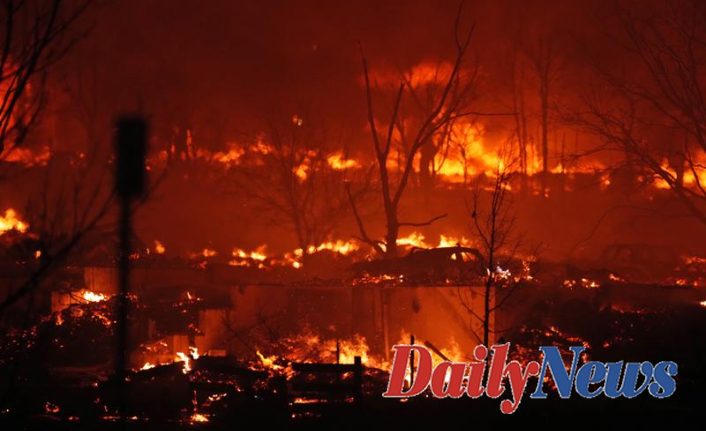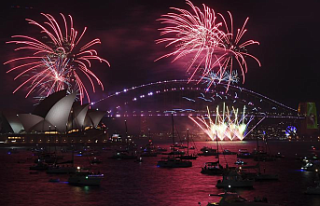The Guanellas were one of the tens of thousands of Denver residents forced to flee their homes after wildfires that were fueled by winds gusting up to 105 mph (169 km/h) destroyed parts of two cities. They also destroyed an estimated 580 homes, a building and a shopping mall.
Guanella, his wife, and their three children, along with their dogs, decided to open Christmas gifts at home in Superior, instead of doing so. Instead, Guanella, his wife, and their three children, were staying in Denver, where they hoped their house would still be standing.
"Those presents are still under a tree right now. . . we hope," Guanella said.
Six others and at least one first responder were hurt in the fires that started Thursday morning. This was unusually late in 2014, after a dry fall and a winter almost devoid of snow. The intensity of the fires that quickly spread across the region could have caused more injuries or even deaths, according to Joe Pelle, Boulder County Sheriff.
Officials were monitoring the wind and fires as night fell to determine when crews can enter and assess the damage and search for victims.
The evacuations were ordered for Louisville and Superior earlier in the day. They are located approximately 20 miles (32 km) northwest of Denver, and home to a total of 34,000 people. Another section of U.S. Highway 36 was also closed.
Nearby towns are home to middle- and upper-middle class subdivisions, surrounded by shopping centers and parks. This area is located between Denver and Boulder, Colorado's foothills college town.
Although residents evacuated calmly and in order, the streets of the subdivisions became blocked quickly as people tried to escape. Sometimes, it took 45 minutes for cars to travel a quarter mile (less than one kilometer) in some cases.
As wind gusts caused fire to spread, small fires sprung up in unexpected places -- in the median grass or in a dumpster at the end of a parking lot -- and they quickly spread. Shifting winds caused clouds to change from clear to smokey and back again, as emergency sirens were blared nearby.
A video taken by a passerby outside Superior Costco showed an apocalyptic scene, with winds blowing through barren trees in the lot. The area was surrounded by gray skies and small fires.
After being away for the holidays, Leah Angstman saw similar skies as her husband when they returned to their Louisville home via Denver International Airport. Angstman, as they sat on the bus heading towards Boulder, recalled immediately leaving clear blue skies to enter clouds of yellow smoke.
She said, "The wind rocked my bus so hard that it seemed the bus would tip."
They had to stop because of the poor visibility. After waiting for half an hour, a van from the regional transit authority escorted them onto the highway.
She said, "The sky was dark and dark brown, and dirt was blowing in swirls along the sidewalk like snakes."
Vignesh Kasinath was an assistant professor of biochemistry at Colorado. He evacuated with his wife and parents from Superior. Kasinath stated that the family was overwhelmed by the emergency evacuation warning and anxious about trying to flee the chaos.
Kasinath stated that he didn't receive an evacuation notice from authorities.
Pelle stated that the first fire broke out just before 10:30 AM. It was "attacked quickly and laid down later in day, and is currently being monitored," with no structures damaged.
Pelle reported that a second wildfire was also reported shortly after 11 a.m. It "ballooned east and spread quickly east," he said. It covers 2.5 miles (6.5 km) of land.
Downed power lines were the catalyst for some of the fires that erupted in the region on Thursday.
Governor. Jared Polis declared a state emergency, which allowed the state to access disaster funds.
Colorado's Front Range, home to most of the state’s residents, experienced a mild and extremely dry fall. Winter so far has been mostly dry. Denver was the first place to have no snow for more than ten consecutive days before it experienced a storm on December 10. Although it hasn't snowed in the area since then, snow was predicted for Friday.
Scientists believe climate change is making wildfires more destructive and extreme. Wildfires in the West have become more difficult to combat due to heat waves and droughts.
Ninety percent (90%) of Boulder County are in extreme or severe drought and haven't had significant rainfall since mid-summer.
"With any snow on ground, this absolutely wouldn't have happened in that way," stated Keith Musselman (snow hydrologist), who was home at the time the fires broke out.
Musselman stated that severe fire danger is likely in September and October after a dry summer. However, the absence of precipitation so late in the season makes it highly unusual.
According to Musselman, Boulder could see up to a foot in snow tomorrow. That moisture will bring significant relief.
Guanella stated that he was told by a friend of a firefighter that the family home was still standing on Thursday night. He can't wait to see if that holds.
Guanella stated, "You're just waiting for confirmation if your favorite restaurant or the schools your children attend are still standing." "You are just waiting for clarity, hopefully tomorrow."












